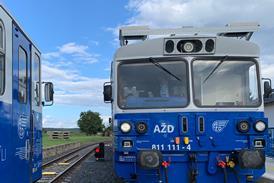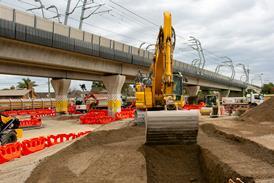CHINA: One of the newest airport links shows technology driving choice. Shanghai's maglev runs non-stop from the terminus of the city's metro Line 2 to the airport, covering the 30 km in 8 min. The maximum speed is 430 km/h, but it takes 4 min to reach this speed, which it holds for just 52sec before it needs to decelerate for the terminus. A shorter journey or more stops might justify the choice of technology, but surely not a headline speed!
Exit 4 from Long Yang Road metro station leads to the maglev station, just across a road. The terminal is large and impressive, and room has been reserved for retail facilities. There is a cafe, souvenir shop and a museum of maglev technology on the ground floor. A VIP lounge is on the first floor, with the ticket office and information desk on the second floor.
Before going up escalators to level three, passengers must pass through a scanner, while their bags are scanned in an ordinary airport x-ray machine. There are four platform faces with two tracks, with boarding on the centre platforms and alighting on the outer. Passengers await the arrival of the train on the platform, and some vibration is noticeable as trains arrive and depart.
Once inbound passengers have disembarked, rope barriers are taken down and the boarding doors are opened by the attendants. There is one attendant in each car and two in the VIP car; they give a welcome message in English and Mandarin.
The trains currently have five cars, but will ultimately have eight. The VIP car has 52 seats, while four standard class vehicles have 110 seats. Both classes are very comfortable. Half of the VIP car has seats in facing bays, and the rest are airline-style with seat-back tables (and advertisements). Standard class cars have 3+3 seating, mainly uni-directional and with no seat-back tables. There are overhead racks and baggage stacks at the ends of the cars, as well as baggage space under and between the seats.
Operation is automatic, although manual driving is possible. Acceleration is rapid and smooth, and there is a speed indicator over the internal doors. Some noise and vibration is evident inside the train, especially as speeds exceed 300 km/h, and it was difficult to write above 400 km/h. There was also a significant pressure pulse as trains pass.
The station at the airport is 5 to 10min walk from the terminal. For inbound passengers the station is not well signed in the terminal, but once in the walkway to the station there is no problem. There is an inconspicuous ticket office in the domestic arrivals area alongside the hotel information kiosks. Part way along the walkway, there is a portable ticket desk with three staff, and at the entrance there is a full ticket office with three positions and an information desk. There is some retail space, but it is little-used.
Access gates validate the tickets and lead to a waiting area where there are LED displays of the time to the next departure, toilets, basic seating, plenty of space and provision for baggage scanning, though this is not currently used for arriving air passengers. Attendants lead the passengers down an escalator to the platforms. Trains come in on the southern platform to unload, run into a reversing siding, and return to load at the northern platform.
There were 20 vehicle and 10 infrastructure maintenance staff. Maintenance costs were said to be a third of a conventional railway, and energy usage a fifth of that of an aircraft.
Transrapid timeline
- June 30 - Nov 20 2000 Feasibility study
- November 28 2000 Contract negotiations started
- January 23 2001 Contract awarded
- August 9 2002 First three cars delivered
- December 31 2002 President Zhu Rongji and Chancellor Schr

















